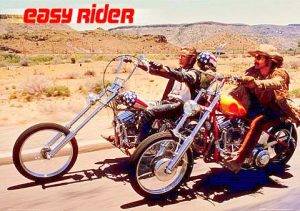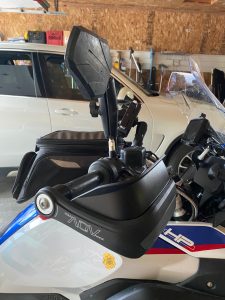Since we have a couple of long multi-day rides coming up this month, I thought I would put together some notes and tips that we have learned over the years that make it easier to handle these long haul rides. For the youngsters, who still have muscle in their butts and testosterone to soothe the aches (yes, girls have testosterone too), this may seem like overkill. But as we gain experience, we also gain scars (which get stiff and sore after many hours in the saddle) so let’s try to make things easier.
Bike Prep
- Saddle sores: those who have ridden for hours and gotten the proverbial numb bum will often first turn to getting a better saddle. Now, this can be helpful, but it is not the first thing to fix. Saddles are not cheap and you don’t get to test ride them. Gel seats feel nice for the first hour but don’t suit everyone for day-long rides. Riding position is much more important. Even small changes make a difference. There was an excellent article in the October 2020 of Motorcycle Mojo, which pointed out that the ergonomic triangle is crucial: getting your knees, hips and ankles right makes more difference. They noted how different heights of riders preferred different custom seats and that much of this was due to these angles. Personally, I have found that the good old sheepskin is cheaper, breathes well, warm in winter, cool in summer (sheep seem to like them!) and is worth trying first.
- Riding position: to continue the theme from above, this makes so much difference. An upright stance solves a lot of problems. Now, we are not going to go into the merits of different styles of bikes: not many people have the money to afford more than one bike and have usually chosen their ride already. I do wonder why cruisers are so popular: that laid-back style looks comfortable but does not hold up for really long rides. But rather than changing your bike, there are small things you can do to modify your riding position which can really help. Beyond the hip-knee-ankle triangle mentioned above, check out your arms and hand height. We’ll say no more about ridiculous things like ape-hangers. Peter Fonda and Dennis Hopper did the world a great disservice in Easy Rider:

Easy Rider (1969). Note the ATGATT. However, small bar risers can bring your hands and elbows back into a more comfortable position.
- Tire pressure: this may or may not make a difference to comfort. But it can help with fuel economy, tire wear and grip. We won’t go into this at length: there are many other articles and advice on pressures. But there are a few things to be aware of: the pressures given on the tire sidewall are maximum pressures, not optimum pressures. Use max pressure when riding fully loaded (or with a pillion) but a wee bit (2-4psi) less is often better for most other situations. Measure when cold, first thing in the morning.
Gear Prep
- Good vision is key: squinting into the glare makes your face and eyes tense up. Thoroughly clean ALL your lenses, including glasses, sunglasses and the helmet’s internal sun visor that often gets forgotten. Use simple soap and hot water: bug carcasses are abrasive so soak them off, not rub them off. Try not to polish your lenses at all but if you do have to rub them, do so in vertical swipes. Any rubbing will introduce microscopic scratches, no matter how careful you are, but these create less glare when they run vertically. Dark lenses obviously help with sun glare but can become a hazard when the light is poor. Photochromic lenses will not darken properly: they need UV to do so and the helmet visor blocks this. For polish and anti-fog visor preps, RyanF9 did a great review of various preps for visors here.
One last tip for those who get dry eyes: try to get some hyaluronic acid eye drops. Acid? Sounds scary. But these are awesome (although a bit expensive) – you will probably need to go to an optometrist store to find them but they should not need a prescription. If anyone is interested, I can add some tips on how to apply them and share them without sharing viruses.
- Avoid the noise: we all know that you need to protect your hearing. But not so many people realize just how draining an effect constant high decibels have. Even the quietest helmets still create greater than 85dB when measured, which will tire you out. So, ear plugs at the very least… but let me put in a plug(!) for active noise-cancelling earbuds. We wrote a wee piece on this last year: olab.ca/music-to-my-ears which has more details. Be careful not to eliminate all noise: you still need to hear traffic around you (indeed, ear plugs are bizarrely illegal in some jurisdictions, but helmet mounted speakers are not). Windshield height also makes a difference. We feel sorry for naked bike riders (ATGATT and ‘Eats Shoots and Leaves’, for our grammar pedants) but OTOH, a maxed-out windshield is not necessarily better – it can create a buffeting effect around the top of your helmet. You can experiment with this, even if you do not have an adjustable windshield, by placing some towels under your butt: sometimes 2-3 cm difference between windshield top and helmet top can make a difference.
- Check the forecast: pay attention to the temperature range for the whole duration and distance of your day’s ride. We each have a fairly narrow range of temp tolerance when riding – as little as a 5C shift can make things unpleasant for a particular amount of gear. Remember, we are sitting still in a 100km/hr gale so the normal ways in which we thermoregulate don’t help much.
- Layers are lovely: as Shrek told us, onions have layers but if you are not an onion, you will have tears in your eyes. Being able to layer up and down means you can tolerate a much wider range of conditions, and we in Canada do get some pretty variable weather. Next to your skin, have some sort of wicking layer (polypropylene, merino etc). Avoid cotton! We highly recommend having a heated vest as one layer – if you ride in the mountains, take it with you every ride. Yes, we have had snow every month of the year in Alberta. OTOH, when it gets really hot (like last week), a mesh jacket can be your friend, but these can be a bit expensive, so even having a range of zipped vents to open will make life much easier.
- Cold hands, warm heart?: well, maybe not but they can be another source of tears. Heated grips are essential in Canada: yes, I have used mine in all seasons. It is also a good idea to consider what type of handguards to use, apart from for crash protection:

ADV guard in down position 
ADVguard in up position I recently installed some adjustable handguards and have been pleasantly surprised how much difference the adjustment makes. Also, remember to take more than one pair of gloves: on the one hand(!), it is nice to have different types for warm and cool days; but, on the other, it is crucial to have a dry pair to change into if you get caught in the rain.
Riding Tips
So, you have prepped your bike and gear, checked the forecast and you’re ready for the road. What can you do when riding to stay comfortable?
- Move around: I am teased with the monniker ‘Dancing Dave’ because I am such a fidget when riding. Very annoying to ride behind which is why they stick me at the back! But it makes a difference. Now, I am blessed with a big ADV bike where it is easy to stand up and move around on the seat. If you are stuck on a cruiser or pocket rocket, you may not be able to do all this. My most effective two dances while riding are ‘Do the Twist (like we did last summer)’, and a somewhat more disturbing pelvic thrust (which looks bizarre but is great for lower back and butt muscle circulation). No, we are very fortunate not to have video footage of either of these dances – I will leave it to your imagination. Now don’t do these in traffic: your stopping distance is longer and the cops will give you a ticket for stunting. Two other less dramatic maneuvers that will help you to stiffen up less: sitting way back on the pillion seat to stretch out your whole back; and dangling a leg down (but be careful not to catch a loose rock – they may be tempting to kick but remember that is a 100km/hr kick!).
- Wet weather coming?: if you see a rain squall ahead, stop and zip up before you reach it. I know it’s obvious but it is amazing how many people think they will just ride around it. Make sure those zips are fully closed, tucking the zipper top into its wee housing. Even a small gap can let in a lot of leakage. Rain will clean off the bug guts but try to let them get well soaked first (see note above about how abrasive they are).
- Muscle cramps?: on longer rides, these increasingly become a problem. The main thing is to avoid dehydration and keep up your fluid intake (which creates a different problem for older bladders). Have a water bottle or Camelbak with a flexible spout so you can drink without taking off your helmet. It’s not that taking off your helmet is a bad thing but it is one more step so you will inevitably drink less. Salt and magnesium supplements can also be helpful. Having a cruise control is lovely: not just to rest the right hand but also to let you shake out your whole shoulder girdle. A throttle grip is cheaper but with both of these (just like with standing and dancing), don’t use them in traffic. Remember to build up your distance: you would not enter a marathon without some training runs. And longer prep rides will allow you to try out some of these tips and test preps.
- Fatigue is the mind killer: (as well as Fear, according to the Bene Gesserit – yes, cultural references in a motorcycle blog!). Stop every 60-90 mins and take a short break. Take #23seconds to admire the view (thanks, Trevor). Remember that we all have a tolerance for caffeine: this means that it will have a diminishing effect with each successive cup. Did you also know that dark roasts have LESS caffeine than light roasts? I kid you not. (However, the other urban myth that tea has more caffeine than coffee is an artefact of the old colorimetric assay that was used and is not true.) Avoid riding with a hangover and remember next day alcohol levels can be higher than you think – it takes more time to metabolize than we often allow for. Also avoid the heavy high carb lunch – that will give you the snoozies big time.
- Avoid being a David Hasselhof Night Rider (for oh so many reasons!): having good lights to pave the way around the bends helps to reduce the risks a wee bit but DEER ARE DUMB AT DUSK! And moose are invisible, even with great lights: their coats soak up the light and their retinas do not glow/reflect. Pop quiz: which animal kills the most people in Canada? Try to start your day earlier – this is true even if you are not a morning person. Our diurnal rhythms make us more alert earlier in the day; and the traffic is lighter before 10AM in the mountains so it is a win-win.
- Group Riding Goodies: longer rides are more fun in groups but take a bit more planning. As mentioned, frequent stops are a great idea, and it is good to plan these out. At least, decide where the next stop is before you start each section – don’t just wing it. Change the riding order: we tend to fall into the same pattern each section but it can keep things more interesting to change it up. Each person has a different style and we can all learn from each other. Group comms are a major bonus: as well as keeping things interesting (“Look, a bear!”), they also keep things safer (“Lookout for the bear!”).
So those are just a few things learned from many long group rides here in western Canada. As the Arrogant Worms reminded us, Canada’s really big.
Addendum: I just came across another excellent blog post from RyanF9. I love his stuff: great factual content, presented with style.
Ryan also takes about dehydration (and, more importantly, pre-hydration), moving around on the saddle (with some great live demonstrations), noise reduction measures. Keep up the great work, Ryan.
Dancing Dave

